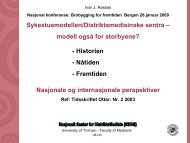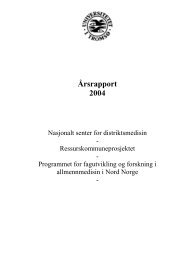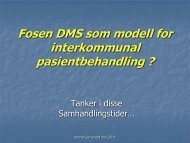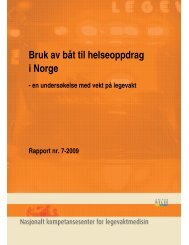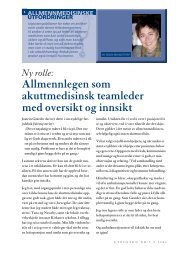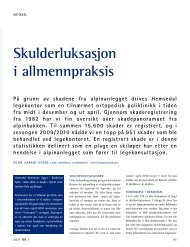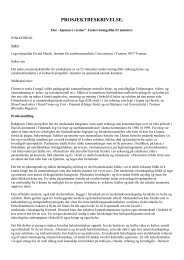Helge Garåsen The Trondheim Model - NSDM
Helge Garåsen The Trondheim Model - NSDM
Helge Garåsen The Trondheim Model - NSDM
Create successful ePaper yourself
Turn your PDF publications into a flip-book with our unique Google optimized e-Paper software.
BMC Health Services Research 2007, 7:133<br />
http://www.biomedcentral.com/1472-6963/7/133<br />
secondary level, and vice versa, have incomplete information<br />
about ADL, medication and patient's network. This is<br />
especially the case if there are uncertainties as to who is<br />
responsible for the follow-up care and as to what needs to<br />
be followed-up. Older patients, many with reduced mental<br />
capacity, are those most dependent on a health care<br />
system that is able to communicate appropriately and to<br />
transfer information and duties properly.<br />
<strong>The</strong> general hospital physicians in the panels had a higher<br />
confidence in the benefit of general hospital care than the<br />
general practitioners did. <strong>The</strong> nurses, on the other hand,<br />
were more confident in community hospital care. Other<br />
studies have demonstrated that specialists have a tendency<br />
to over-estimate the effect of their own specialty<br />
[20,26]. However, several studies in Norway, the Netherlands<br />
and UK confirm that appropriate care can be given<br />
at an intermediate level [27]; at community hospitals or at<br />
general practitioners hospitals [28-30]. We believe that<br />
this disagreement between professionals as to the benefit<br />
of a general hospital admission may be one of the greater<br />
challenges for the understanding of professional collaboration.<br />
<strong>The</strong>re has to be a much better dialog between physicians<br />
at primary and secondary level to establish a<br />
consensus as to the definition of proper care, and what it<br />
entails. This may prevent unnecessary referrals to general<br />
hospitals and ensure appropriate follow-up care for<br />
patients after discharge from general hospitals.<br />
Physicians' letters of poor quality are probably one of several<br />
factors contributing to inappropriate care. Without<br />
correct information about the patients' ADL and normal<br />
medical status, general hospital physicians have to deal<br />
with each disease as an isolated medical problem without<br />
any possibility of seeing the consequences of the present<br />
disease in the patient's daily social context. This in turn<br />
may result in discharge letters being written mostly from<br />
a general hospital point of view without necessarily<br />
addressing the problems that caused the referral in the<br />
first place.<br />
This study, along with other similar studies [3-16], demonstrates<br />
the importance of establishing better systems for<br />
exchanging patient information between primary and secondary<br />
level. We also believe that it will be necessary, in<br />
the future, for health professionals to reach a consensus as<br />
to a definition of what is necessary information and<br />
appropriate care at primary and a secondary level. Today<br />
there would appear to be uncertainties between the health<br />
care levels about duties, responsibilities and possibilities<br />
of the care that can be provided by general hospitals or by<br />
primary care.<br />
Conclusion<br />
In this study from one general hospital the quality of vital<br />
medical information between the health care levels and<br />
between physicians in order to provide appropriate care<br />
for older patients was insufficient and might represent<br />
potential health hazards for older patients. It is necessary<br />
to establish a better common consensus between health<br />
professionals as to the content and the form of professional<br />
communication between the care providers at primary<br />
and secondary level.<br />
Competing interests<br />
<strong>The</strong> author(s) declare that they have no competing interests.<br />
Authors' contributions<br />
HG and RJ developed the idea of, and the design of, the<br />
study together. HG was the project coordinator and mediator<br />
in the panels, performed the statistical analysis, interpreting<br />
the data and drafted the manuscript. RJ helped<br />
with the statistical analyses, interpreting the data and the<br />
drafting of the manuscript. Both authors have read and<br />
approved the final manuscript.<br />
Acknowledgements<br />
<strong>The</strong> study was supported by grants from <strong>The</strong> Norwegian Association of<br />
Local and Regional Authorities (KS), Oslo, Norway.<br />
<strong>The</strong> authors wish to thank Olav Sletvold, Bjørg Viggen, Eva Rinnan, Hilde<br />
Carin Storhaug, Tove Røsstad and Torgeir Fjermestad for their indispensable<br />
participation as panel experts.<br />
References<br />
1. Newton J, Eccles M, Hutchinson A: Communication between<br />
general practitioners and consultants; what should their letters<br />
contain? BMJ 1992, 304:821-4.<br />
2. Norwegian Centre for Informatics in Health and Social Care<br />
(KITH 2002 [http://www.kith.no/upload/1085/R32-<br />
02EpikriseMedFagligInnhold.pdf]. <strong>Trondheim</strong>, Norway: KITH<br />
Accessed 4 Aug 2006, [Website in Norwegian].<br />
3. Bolton P, Mira M, Kennedy P, Lahra MM: <strong>The</strong> quality of communication<br />
between hospitals and general practitioners: an<br />
assessment. J Qual Pract 1998, 18:241-7.<br />
4. Rognstad S, Strand J: Do general practitioners know what medication<br />
community nurse give their shared patients? [In Norwegian].<br />
Tidsskr Nor Laegeforen 2004, 124:810-12.<br />
5. Tuomisto LE, Marina E, Minna K, Brander PE, Ritva K, Hannu P, Pertti<br />
K: <strong>The</strong> Finnish asthma programme; communication in<br />
asthma care-quality assessments of asthma referral letters.<br />
J Eval Clin Pract 2007, 13:50-4.<br />
6. Jensen SA, Øien T, Jacobsen T, Johnsen R: Erroneous drug charts<br />
– a health hazard? [In Norwegian]. Tidsskr Nor Laegeforen 2003,<br />
123:3598-9.<br />
7. Glintborg B, Andersen SE, Dalhoff K: Insufficient communication<br />
about medication use at the interface between hospital and<br />
primary care. Qual Saf Health Care 2007, 16:34-9.<br />
8. Kasje WN, Denig P, De Graeff PA, Haaijer-Ruskamp FM: Physicians'<br />
views on joint treatment guidelines for primary and secondary<br />
care. Int J Qual Health Care 2004, 16:229-36.<br />
9. Kværner KJ, Tjerbo T, Botten G, Aasland OG: Hospital discharge<br />
information as a communication tool. [In Norwegian].<br />
Tidsskr Nor Laegeforen 2005, 125:2815-7.<br />
10. Solet DJ, Norvell JM, Rutan GH, Frankel RM: Lost in translation:<br />
challenges and opportunities in physician-to-physician communication<br />
during patient handoffs. Acad Med 2005, 80:1094-9.<br />
Page 6 of 7<br />
(page number not for citation purposes)



